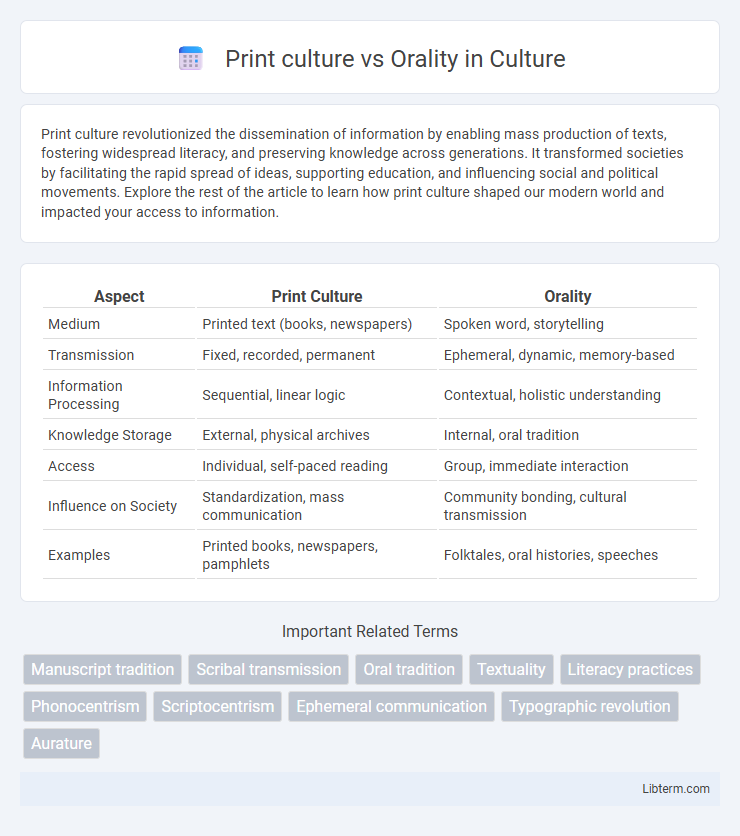Print culture revolutionized the dissemination of information by enabling mass production of texts, fostering widespread literacy, and preserving knowledge across generations. It transformed societies by facilitating the rapid spread of ideas, supporting education, and influencing social and political movements. Explore the rest of the article to learn how print culture shaped our modern world and impacted your access to information.
Table of Comparison
| Aspect | Print Culture | Orality |
|---|---|---|
| Medium | Printed text (books, newspapers) | Spoken word, storytelling |
| Transmission | Fixed, recorded, permanent | Ephemeral, dynamic, memory-based |
| Information Processing | Sequential, linear logic | Contextual, holistic understanding |
| Knowledge Storage | External, physical archives | Internal, oral tradition |
| Access | Individual, self-paced reading | Group, immediate interaction |
| Influence on Society | Standardization, mass communication | Community bonding, cultural transmission |
| Examples | Printed books, newspapers, pamphlets | Folktales, oral histories, speeches |
Introduction to Print Culture and Orality
Print culture revolutionized information dissemination by enabling mass production of texts, which standardized language and preserved knowledge across generations. Orality, rooted in spoken word traditions, relies on memory, storytelling, and communal interaction to transmit culture and knowledge dynamically. The transition from orality to print culture marks a shift from ephemeral, context-dependent communication to fixed, widely accessible records that shape cognitive frameworks and societal structures.
Historical Overview of Oral Traditions
Oral traditions date back to prehistoric times, serving as the primary means of preserving history, laws, and cultural knowledge through storytelling, poetry, and songs. These oral narratives shaped societies before the widespread adoption of print culture following the invention of the printing press by Johannes Gutenberg in the 15th century. The shift from orality to print facilitated the standardization of language and the mass dissemination of information, profoundly transforming cultural transmission and historical record-keeping.
The Emergence and Impact of Print Culture
The emergence of print culture in the 15th century, marked by Gutenberg's invention of the printing press, revolutionized information dissemination by enabling mass production of books and texts. This shift from orality to print standardized knowledge transmission, facilitated wider literacy, and fostered the spread of scientific ideas and religious reform movements such as the Protestant Reformation. Print culture established fixed, reproducible texts that challenged the fluid, communal nature of oral traditions, reshaping education, communication, and cultural preservation.
Key Differences Between Orality and Print
Orality relies on spoken language and memory, emphasizing communal participation and fluid storytelling, whereas print culture depends on written text, promoting fixed, permanent records and individual interpretation. Oral traditions prioritize mnemonic devices and repetitive patterns to aid transmission, while print culture facilitates widespread dissemination and standardized knowledge through mass reproduction. The shift from orality to print marks a transformation in cognition, communication, and the social organization of knowledge.
Cognitive Effects: Memory, Learning, and Communication
Print culture enhances memory retention by externalizing information, allowing repeated access and deeper cognitive processing compared to orality's reliance on episodic recall and mnemonic devices. Learning through print promotes analytical thinking and individual reflection, fostering structured knowledge acquisition, whereas orality emphasizes communal learning, storytelling, and oral transmission of knowledge. Communication in print culture is fixed, enabling precise information dissemination and critical evaluation, while orality relies on dynamic, context-dependent interactions that engage auditory and social cognitive skills.
Social Structures Shaped by Orality and Print
Orality fosters social structures based on communal memory, face-to-face interaction, and collective storytelling, reinforcing local identities and oral traditions. Print culture, by contrast, promotes standardized knowledge dissemination, creating more hierarchical and institutionalized social frameworks through widespread literacy and document preservation. The shift from orality to print restructures power dynamics by enabling broader information access and facilitating bureaucratic governance.
Knowledge Preservation and Transmission
Print culture revolutionized knowledge preservation by enabling the creation of durable, standardized texts that could be widely disseminated and stored for centuries, ensuring consistent transmission of information across generations. Orality relies on memory and spoken word, which facilitates dynamic and adaptive knowledge exchange but is vulnerable to alteration and loss over time. The shift from oral traditions to print culture marked a transformation in how societies maintain and pass on intellectual heritage, favoring permanence and accessibility over fluidity and personalization.
Influence on Language Development
Print culture significantly accelerated standardization of language by promoting consistent spelling, grammar, and vocabulary through widely distributed texts, enhancing literacy rates and formal education. Orality, characterized by spoken traditions and localized dialects, preserved linguistic diversity and facilitated adaptive, context-driven language use rooted in communal memory. The interaction between print culture and orality shaped language evolution by balancing permanence and fluidity, impacting linguistic norms and cultural identity.
Technological Advances and the Shift to Print
Technological advances such as the invention of the printing press by Johannes Gutenberg in the 15th century revolutionized the dissemination of knowledge by enabling mass production of texts, leading to a shift from orality to print culture. This shift facilitated standardized information, widespread literacy, and the preservation of complex ideas through written records. Print culture enhanced cognitive patterns by promoting linear and analytical thinking, contrasting with the mnemonic and communal nature of orality.
Contemporary Relevance: Digital Age and Hybrid Models
Digital age innovations have transformed print culture and orality by fostering hybrid communication models that blend text-based media with oral traditions through podcasts, social media, and video content. These hybrid models enhance accessibility and engagement, allowing oral narratives to coexist with printed texts in digital formats, thus revitalizing cultural transmission and knowledge sharing. The convergence of print and oral media in the digital era underpins contemporary education, entertainment, and information dissemination, reflecting a dynamic interplay between legacy and innovation.
Print culture Infographic

 libterm.com
libterm.com